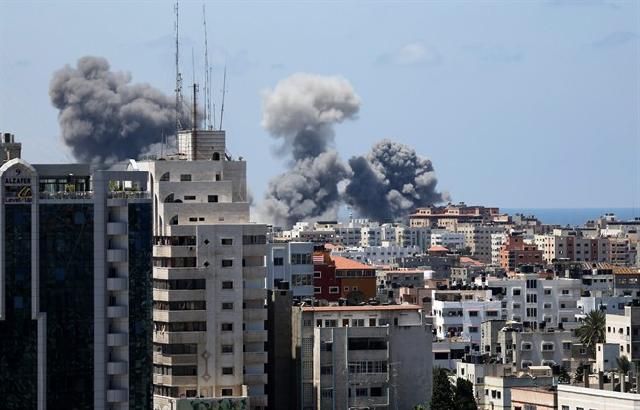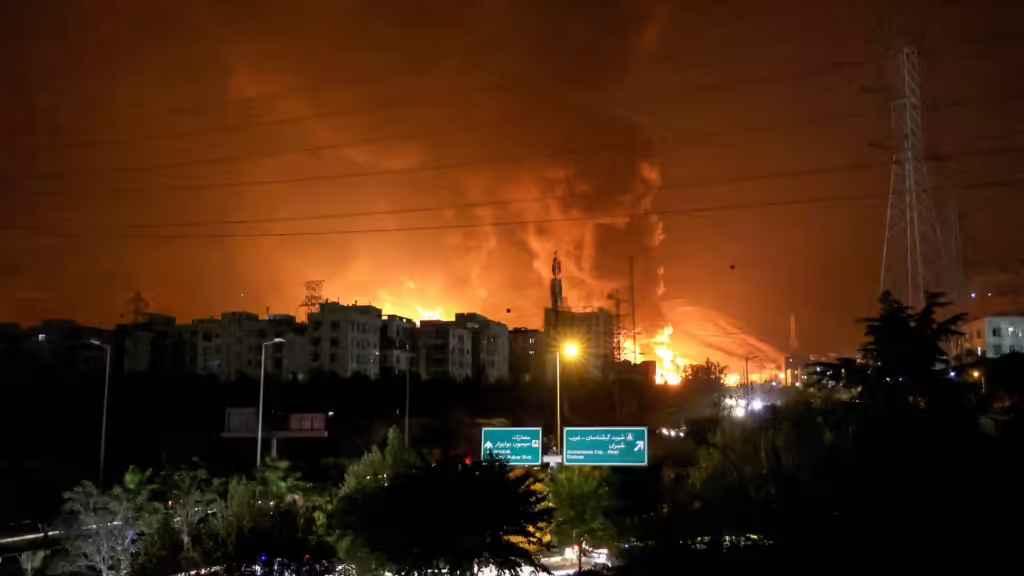UPDATES
Hamas’ other terror tactic: intimidating foreign journalists
July 28, 2014 | Gabrielle Debinski

As the conflict between Israel and Hamas enters its third week, foreign journalists are increasingly flocking to the region, reporting from both Gaza and within Israel. In addition, more and more accounts of intimidation and abuse towards foreign journalists stationed in the Strip, both via social media as well as from Hamas operatives on the ground, are emerging.
In recent weeks several foreign journalists have released details of threats, intimidation and blackmail directed against them in the wake of their reporting on the reality as they see it in Gaza. Much of this abuse has stemmed from journalists’ coverage of Hamas’ tactic of firing rockets into Israel from civilian institutions or highly populated civilian areas. At the same time, reports relating to Hamas’ use of Gaza’s Shifa hospital – the largest and most important in the Gaza Strip – as a ‘hotbed’ for storing weapons and launching rockets has also elicited intimidation from Hamas operatives in Gaza – as well as threats and abuse from pro-Palestinian advocates online.
In one Australian example, reporter Peter Stefanovic of Channel Nine News, stationed in Gaza, became the target of considerable online abuse after tweeting that he had seen rockets fired into Israel from civilian areas in the Gaza Strip.
Stefanovic’s tweet read: “Hamas rockets just launched over our hotel from a site about two hundred metres away. So a missile launch site is basically next door.”
Soon after, a surge of abusive tweets began circulating online – some even threatening to sue the channel nine reporter, and others hinting that he should be shot as a spy.
According to the Jerusalem Post, one account called @ThisIsGaza said Stefanovic was “passing and fabricating information to Israel… from GAZA,” while another account, tweeted to Stefanovic: “You are a cretin. Are you working for the IDF” and “in WWII spies got shot.”
Similarly, Financial Times Jerusalem bureau chief John Reed tweeted of seeing “two rockets fired toward Israel from near al-Shifa hospital, even as more bombing victims were brought in.”
In the wake of publishing this account, John Reed too became the target of a barrage of online threats, being labelled an “informant” by one twitter user, and urged to “get out of Gaza.” Another abusive tweet directed at Reed said: “We’ll hold you responsible if Israel uses your tweet to bomb the hospital & then justify it” as well as he’s “subtly justifying and encouraging IDF attacks on hospitals.”
It is important to note that Shifa hospital is the main medical facility in Gaza and there are reports that it is also being used as the control centre for Hamas’ military wing (as highlighted in an earlier FreshAir blog by Sharyn Mittelman) – in addition to the reports about rockets being fired from close by the hospital. It seems to be a particularly sensitive issue for the Hamas government and also illustrates the extent to which Hamas believes it can control reporting through intimidation. Despite the fact that Hamas spokesmen openly hold press conferences inside the hospital, there seems to be an expectation that no reporter will dare report this fact.
A good case in point involves reporter Nick Casey from the Wall Street Journal. On July 21, Casey, the WSJ’s Middle East correspondent, posted a photo on twitter of a chief Hamas spokesman being interviewed for TV by a reporter and camera crew. The irony captured in Casey’s photo was twofold.
First, the Hamas leader was giving the interview from a room in Gaza’s Shifa hospital itself, confirming Israel’s claim that the medical facility is being used as a “de facto headquarters for Hamas leaders” along with other civilian institutions such as mosques, schools and private homes. Secondly, the Hamas spokesman was sitting in front of a makeshift backdrop of a destroyed house, rubble and fire.
Casey tweeted an image of the interview set-up with the accompanying caption: “You have to wonder [with] the shelling how patients at Shifa hospital feel as Hamas uses it as a safe place to see media.”
Almost immediately, the WSJ reporter became the target of a flood of online abuse and threats. Perhaps not surprising, only two days later, on July 23, the tweet was deleted. However, even after it was taken down, pro-Palestinian twitter accounts continued to attack Casey, including him on lists of “journos in Gaza [who] lie/fabricate info for Israel” and “must be sued for crimes.”
Then there was the case of French-Palestinian journalist Radjaa Abu Dagga, who experienced not only threats but open physical intimidation, apparently by official Hamas security forces. He has told of his traumatic experience after having been forcibly blocked from leaving Gaza when he tried to leave for Egypt so he could fly home to France where he lives with his wife and son.
In an account in the online newspaper, The Algemeiner, Dagga says he was not only detained and interrogated by members of Hamas’ al-Qassam Brigade, but he also reports that this interrogation was at Gaza’s Shifa hospital, next to its emergency room.
The paper notes:
“After four blocked attempts to leave Gaza without explanation over weeks, the Palestinian journalist was summoned by the security services of Hamas on Sunday. ‘I received a call from a private number. They summoned me to Al-Shifa Hospital in the Gaza City centre,’ explains Radjaa. He carried with him his two phones, his press card and a small camera.
A few meters from the emergency room where the injured from bombings are constantly flowing, in the outpatient department, he was received in ‘a small section of the hospital used as administration’ by a band of young fighters. They were all well dressed, which surprised Radjaa, ‘in civilian clothing with a gun under one’s shirt and some had walkie-talkies.’ He was ordered to empty his pockets, removing his shoes and his belt then was taken to a hospital room ‘which served that day as the command office of three people.’
A man begins his interrogation: ‘Who are you? Who do you call? What are you doing?’ ‘I was very surprised by the procedure,’ admits Radjaa, who showed him his press card in response. Questions came. They asked if he speaks Hebrew, he has relations with Ramallah. Young Hamas supporters insistently ask the question: ‘Are you a correspondent for Israel?’ Radjaa repeated that he only works for French media and a chain of Algerian radio.
It was then that the three men delivered this message: ‘This is yours to choose. We are an executive administration. We will carry the message of Qassams. You have to stay at home and give us your papers.’ Stunned to be covered by the Ezzedine al-Qassam Brigades, the armed wing of Hamas, Radjaa tried to defend himself and especially to understand why such a decision was taken against him. In vain. ‘It is impossible to communicate with these people,’ laments the journalist.”
Abuse and threatening of foreign journalists stationed in Gaza is not a new phenomenon. In fact, the suppression of free media has been widely reported since Israel withdrew from the Strip back in 2005. Even Human Rights Watch, an NGO known for its persistent and one-sided criticism of Israel and seemingly unwavering support for the ‘Palestinian cause’ released a report in April 2011, detailing the increased instances of abuse and violence by Hamas and PA operatives against foreign journalists stationed both in Gaza and Palestinian areas in the West Bank.
When asked about the 35-page report titled, ‘No News is Good News: Abuses against Journalists by Palestinian Security Forces’ back in 2011, then Deputy Middle East Director at Human Rights Watch, Joe Stork, said:
“Palestinian security forces are becoming notorious for assaulting and intimidating journalists who are just trying to do their jobs.”
“Both the Palestinian Authority in the West Bank and Hamas in Gaza need to end these blatant attacks on free expression.”
Hamas appears determined to win the ‘media war’ by making sure that journalists find it too costly or dangerous to tell the truth: that Hamas is deliberately using hospitals and civilian areas to launch their acts of terror, making any Israeli response look barbaric to the rest of the world.
Hamas’ modus operandi is not new or surprising. What is perplexing, however, is that with countless foreign journalists stationed in Gaza only a minority have chosen to mention that Hamas operatives are operating openly from inside hospitals, weapons in tow, or firing rockets from outside their hotel windows, or to expose the intimidation they are subject to when they do report this reality. Indeed, one can only wonder why?
Gabrielle Debinski
Tags: Anti-Zionism





